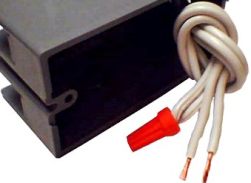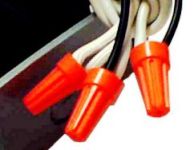Categories: Featured Articles » Electrician at home
Number of views: 135709
Comments on the article: 22
PPE caps insulating for twisting wires
Description of PPE caps, their purpose and application.
 The connection of the conductors of wires of any electrical wiring should only be carried out using certified terminals simple twists, even with the use of electrical tape are not allowed. When it comes to household wiring, the caps insulating caps of PPE are very often used as such clamps.
The connection of the conductors of wires of any electrical wiring should only be carried out using certified terminals simple twists, even with the use of electrical tape are not allowed. When it comes to household wiring, the caps insulating caps of PPE are very often used as such clamps.
The main reason for their mass distribution is ease of use. What are they like?
PPE cap - this, oddly enough, is really a cap made of plastic compound that does not support combustion. Inside this cap is a conical metal spring. When the PPE is twisted with effort into twisting, the spring coils move apart and compress the wires of the wires, and the plastic cover of the cap provides electrical insulation, fire protection and mechanical protection.
 Of course, all this happens only when the PPE cap is correctly selected for its nominal value. The fact is that PPEs are classified by the total cross-sectional area of the twisted cores. This area is characterized by numbers - the number of personal protective equipment, which can be from 1 to 5. The larger the number of personal protective equipment, the more wires of a larger cross-section it can "twist".
Of course, all this happens only when the PPE cap is correctly selected for its nominal value. The fact is that PPEs are classified by the total cross-sectional area of the twisted cores. This area is characterized by numbers - the number of personal protective equipment, which can be from 1 to 5. The larger the number of personal protective equipment, the more wires of a larger cross-section it can "twist".
But here we must be careful. The fact is that there are domestic and European standards for PPE caps. Both there and there the denomination of PPE is indicated by a number, but European PPE is much smaller. Therefore, when choosing PPE caps, it is better to focus not on their number, but on the total cross-section of the wires, which is always indicated on the package.
 If in work you use PPE of too small or large denomination, then it will not be able to pinch your twist, fly off and prove to be useless, or even dangerous to operate. In addition, you must remember that with the help of PPE it is impossible to connect aluminum and copper wires to each other - in this case, only a terminal block or clip with a transition metal plate can be useful.
If in work you use PPE of too small or large denomination, then it will not be able to pinch your twist, fly off and prove to be useless, or even dangerous to operate. In addition, you must remember that with the help of PPE it is impossible to connect aluminum and copper wires to each other - in this case, only a terminal block or clip with a transition metal plate can be useful.
Usually, the color of PPE does not have any practical value; it is not specified by the standards and requirements of the PUE. But if desired, you can always use, for example, brown PPEs for twisting phase conductors, blue ones for twisting zero wires, and yellow or green PPEs for twisting protective zero wires. Sometimes it’s convenient.
See also at bgv.electricianexp.com
:
